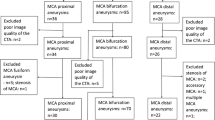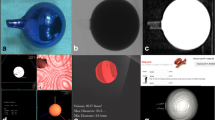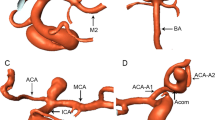Abstract
Intracranial aneurysms usually occur at arterial bifurcations. However, in middle cerebral artery (MCA) aneurysms, we often find that the aneurysmal neck does not necessarily exist just on the arterial bifurcation. In this study, we have evaluated the relation among aneurysmal neck, parent artery, and daughter arteries in middle cerebral artery aneurysms, by three-dimensional digital subtraction angiography. Twenty consecutive patients (9 men and 11 women) with MCA aneurysms were examined. The total number of aneurysms was 22, of which 10 aneurysms were unruptured and 12 were ruptured. Aneurysmal sizes and angles between the parent artery and each of the two daughter arteries were measured. Furthermore, aneurysms were classified into two types based on neck location. Thus, when the neck was located on the extension of the midline of the parent artery, it was defined as a classical neck type aneurysm, and when it was not, it was defined as a deviating neck type aneurysm. There were 15 cases of deviating and 7 cases of classical neck type. Interestingly, in the deviating neck type, all the aneurysms existed on the side of the daughter arteries of which the angles between parent arteries were narrower, and in 93%, the sizes of the daughter arteries in which the neck existed were smaller compared with other daughter arteries.




Similar content being viewed by others
References
Andrews RJ, Spiegel PK (1979) Intracranial aneurysms: age, sex, blood pressure and multiplicity in an unselected series of patients. J Neurosurg 51:27–32
Brown N (1991) A mathematical model for the formation of cerebral aneurysms. Stroke 22:619–625
Campbell GJ, Eng P, Roach MR (1981) Fenestrations in the internal elastic lamina at bifurcations of human carotid arteries. Stroke 12:489–496
Ferguson GG (1972) Physical factors in the initiation, growth, and rupture of human intracranial saccular aneurysms. J Neurosurg 37:666–677
Forbus WD (1930) On the origin of military aneurysms of the superficial cerebral arteries. Bull Johns Hopkins Hosp 47:239–284
Foutrakis GN, Yonas H, Sclabassi RJ (1999) Saccular aneurysm formation in curved and bifurcating arteries. Am J Neuroradiol 20:1309–1317
Gary G (1972) Physical factors in the initiation, growth and rupture of human intracranial saccular aneurysms. J Neurosurg 37:666–677
Glynn LE (1940) Medial defects in the circle of Willis and their relation to aneurysm formation. J Pathol Bacteriol 51:213–222
Sekhar LN, Heros RC (1981) Origin, growth and ruprure of saccular aneurysm. Neurosurgery 8:248–260
Stehbens WE (1959) Medial defects in the cerebral arteries of man. J Pathol Bacteriol 78:179–185
Stendel R, Pietila T, Hassan A, Schilling A, Brock M (2000) Intraoperative microvascular Doppler ultrasonograpy in cerebral aneurysm surgery. J Neurol Neurosurg Psychiatry 68:29–35
Tanoue S, Kiyosue H, Kenai H, Nakamura T, Yamashita M, Mori H (2000) Three-dimensional reconstructed images after rotational angiography in the evaluation of intracranial aneurysms: surgical correlation. Neurosurgery 47:866–871
Wilson G, Riggs HE, Rupp C (1954) The pathologic anatomy of ruptured cerebral aneurysms. J Neurosurg 11:128–134
Author information
Authors and Affiliations
Corresponding author
Rights and permissions
About this article
Cite this article
Sadatomo, T., Yuki, K., Migita, K. et al. Evaluation of relation among aneurysmal neck, parent artery, and daughter arteries in middle cerebral artery aneurysms, by three-dimensional digital subtraction angiography. Neurosurg Rev 28, 196–200 (2005). https://doi.org/10.1007/s10143-005-0379-4
Received:
Revised:
Accepted:
Published:
Issue Date:
DOI: https://doi.org/10.1007/s10143-005-0379-4




